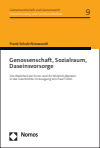Genossenschaft, Sozialraum, Daseinsvorsorge
Die Wahrheit der Form und ihr Wirklich-Werden in der Geschichte im Ausgang von Paul Tillich
Zusammenfassung
Im Ausgang der Theorie der wahren Lebensform des religiösen Sozialismus bei Paul Tillich geht um die Analyse (1) des Innenraums der Genossenschaft als Sozialraum der Förderung der Lebenslagen der Mitglieder, (2) der Genossenschaft im Sozialraum als Förderung der Lebensverhältnisse des Sozialraums als Netzwerke einer solidarischen Sorgekultur in den Quartieren und (3) des Sozialraums selbst als verfasste Gemeinde als Genossenschaft. Es geht demnach um eine Morphologie der Metamorphosen in konzentrischen Wachstumskreisen einer Diffusion im Kontext kommunaler Daseinsvorsorge. Ergänzt wird die Analyse durch eine Skizze der Idee der Genossenschaft als Organisationsprinzip auf nationaler, europäischer und völkerrechtlicher Ebene andererseits.
Abstract
Starting from Paul Tillich's theory of the true form of life of religious socialism, it is a matter of analyzing (1) the interior of the cooperative as a social space for the promotion of the living conditions of its members, (2) the cooperative in the social space as the promotion of the living conditions of the social space as networks of a solidary culture of care in the neighborhoods, and (3) the social space itself as a constituted community as a cooperative. Accordingly, it is a matter of a morphology of metamorphoses in concentric growth circles of a diffusion in the context of local/regional services of general interest. The analysis is complemented by a sketch of the idea of the cooperative as an organizational principle on the national, European and international legal level on the other hand.
Schlagworte
Daseinsvorsorge Genossenschaftswesen Personalismus Sozialpolitik Sozialraum Altern Caring Community Personalität Paul Tillich Kritische Theorie- Kapitel Ausklappen | EinklappenSeiten
- 13–18 Vorwort 13–18
- 95–106 Fazit 95–106
- 107–112 Ausblick 107–112
- 113–144 Literatur 113–144

